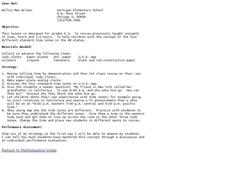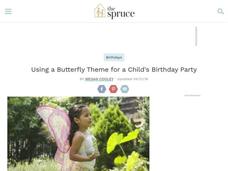Curated OER
Zone Out!
Students review telling time to the hour and half hour on an analog clock. In this time lesson, the students learn how to determine the time in each of the 4 standard time zones.
Curated OER
Flat Shapes in Three Dimensions
Students examine the 20th-century sculpture "Gandydancer's Dream" by Mark di Suvero. In this visual arts lesson, students examine the sculpture and then use flat shapes and wire to create their own sculpture. The students are...
Curated OER
Come On, You Can Trust Me
Fourth graders see how to define and then recognize a variety of propaganda techniques at work in their everyday world. Choosing one technique, they creatively demonstrate a thorough understanding from real world experiences. A very rich...
Curated OER
Machines: Useful But Dangerous
First graders study, observe, and use a simple machine. They study necessary safety and review posted safety rules related to using a machine and identify strategies for reporting any accidents or injuries.
Curated OER
Wish Boxes
I love these are lesson ideas! Young artists practice the art of Calligraphy and Origami. They make gift boxes with good wishes. This plan includes an excellent component that shows exactly how to fold the paper in order to make the box,...
Curated OER
The House
Oú est la cuisine? Several activities are suggested here to develop and further vocabulary acquisition for your beginning French speakers. They draw pictures of different rooms in a house and place objects around the room. Then, using...
Utah Education Network (UEN)
Candies R Us
A box is fun to make, especially when it's a candy box! These activities help to cement understanding of the difference between surface area and volume. Have individuals measure the surface area of their box in two-dimensions before...
PHET
Planet Designer: Martian Makeover
Mars used to have liquid water, can you make it come back? Use the lesson and simulation to understand why Mars lost its magnetic field, why atmosphere is important, and what gravity has to do with it. This is the third lesson...
Curated OER
Listening Devices
Students design and construct a listening device that will allow them to listen to the sound generated by specific object inside a box.
Curated OER
Caterpillar to Butterfly
Students draw the life cycle of a butterfly. In this life cycle lesson plan, students read about and discuss the life cycle and then draw what they have learned.
Guam Community College
Joseph Had a Little Overcoat
Spruce up a class reading of the children's book Joseph Had a Little Overcoat by Simms Taback with this fun series of activities. Starting with a list of reading comprehension questions and key vocabulary to address during a teacher...
Curated OER
Botany: How does the rice plant grow in water?
Second graders read about how rice grows in water and make a rainstick when they are done. In this rice lesson plan, 2nd graders make a rain stick out of rice, posterboard, scissors, glue, and a cardboard tube.
Curated OER
How Much is a Million?
Fifth graders explore the relationship between customary and metric units of measurement. Through discussion and hands-on activities, they discover how units of measurement are related. Students create a millions book to aid in their...
Curated OER
Introduction to Time
Learners explore the concept of time. Through discussion and artistic projects, they define time in their own words and tell how it is used to represent the seasons. Students draw a picture to portray time as it elapses during the...
Curated OER
Sundials: Observing and Using Shadows
Students build sundials and observe changes in shadows over the course of one or more days. They identify patterns in the shadows and discuss how shadows may be used to tell time.
Curated OER
How Air Moves In and Out of the Lung
Students gain an understanding of the respiratory system. In this biology lesson plan, students demonstrate how air enters and leaves the lungs, and explore the relationship between breathing rate and exercise.
Curated OER
Positive and Negative Charge Using Balloons
Fourth graders observe and explain how balloons rubbed on a shirt create positive and negative charges. In this positive and negative charge lesson plan, 4th graders record their results and explain their findings.
Curated OER
Rock and Mineral Uses
Second graders investigate the various uses of rocks and minerals. They examine various rocks and minerals, identify the uses of rocks and minerals, and complete a worksheet.
Curated OER
How Logical is Garfield?
Third graders analyze comics found in the newspaper for samples of logical, emotional, and ethical appeal. They write a paragraph for each selected comic strip explaining how the comic strip represents the use of logic, emotions, or ethics.
Curated OER
Using Geometric Shapes in Architecture
Third graders identify two and three dimensional shapes used in architectural designs by viewing images on the Internet. In this geometry instructional activity, 3rd graders create their own building designs and identify the...
Curated OER
How the Body's Immune System Responds to a Virus
Students study the immune system. In this biology lesson plan, students explore illustrations that show how viruses can appear as foreign invaders in the blood. Students also role play how the immune system responds to a virus.
Curated OER
To an Inch and Beyond!
Third graders measure in multiples of inches. For this measurement lesson, 3rd graders employ a variety of strategies to measure several items in inches.
Curated OER
4 Steps to Road Safety
Students identify the "4 Steps for Kids" and how they can stay safer. In this important rules lesson plan, students take measurements and refer to a chart to identify their Safety Seat Number. Students also...
Curated OER
How Much Energy Does the Earth Receive from the Sun?
Learners explore energy. For this science lesson, students conduct an experiment in which they measure how much energy is produced by the sun. Learners build a calorimeter to measure the amount of energy.

























